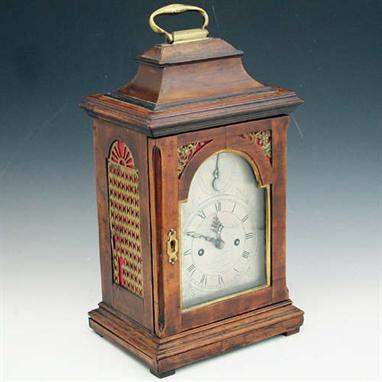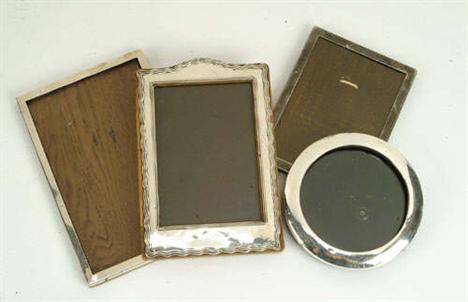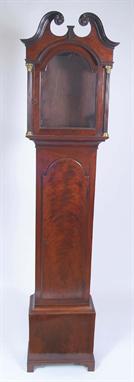A late 18th Century mahogany longcase clock the hood with cushion top and four pillars to the sides enclosed by an arch top glazed door, the trunk enclosed by a rectangular crossbanded door, having an arch top brass dial with decorated spandrils and silvered chapter ring signed James Smoult, Newcastle to the arch, fitted an eight day movement, 224cm (88") high
We found 42009 price guide item(s) matching your search
There are 42009 lots that match your search criteria. Subscribe now to get instant access to the full price guide service.
Click here to subscribe- List
- Grid
-
42009 item(s)/page
A late 18th Century oak cased 8-day Long-case Clock, Davy of Norwich, the arched hood with shaped pediment over panelled freestanding columns, with brass capitals, over an ogee throat and long arched trunk door to a plinth base, to an 11 ½” first period painted dial, with rosette and urn gilt highlighted decoration to the arch and rural trophy spandrels, to Roman and Arabic chapter ring, with subsidiary seconds and date sector and pierced steel hands, to an Osborne stamped false plate and movement united by four knopped pillars, and anchor escapement with rack strike on a bell, height 81”
A mid-19th Century mahogany automaton 8-day Longcase Clock, Fisher of Birmingham, the arched hood with swan neck pediments over freestanding gilt metal mounted and reeded columns, to a moulded throat with plain frieze over further quarter columns and short trunk door and panelled base on bracket feet, to a 13 ½” third period painted Roman dial with a rocking ship automaton to the arch over painted spandrels depicting Maidens of the Empire, enclosing a Roman chapter ring with outside minute track, subsidiary seconds and date sector, with pierced and stamped brass hands, to a W Francis false plate, and movement united by four knopped pillars with anchor escapement and strike on a bell (lacking), height 90”
A French brass mounted mahogany cylinder front bonheur du jour, circa 1880, outlined throughout with brass mouldings and inlaid with brass flutes beneath balustraded galleries with swagged drapery, the back with a shelf above an arch and bevelled rectangular mirror, the pillar supports on two pairs of shallow drawers, the cylinder enclosing a fitted interior with sliding writing surface above a shallow drawer, on tapering legs, 153cm high, 79cm wide, 48cm deep (faults)
A George III oak and mahogany banded longcase clock with arch glazed hood and shaped trunk door and quarter column reeded sides, the 13 inch arch brass dial with 'Tempus Fugit' in arch and silverised chapter ring with Roman and Arabic numerals and date indicator with mask spoundrels, the eight day movement striking on a bell, 230cm high
A 'Grandmother' longcase clock, the arch brass dial signed Moore, London, the black lacquered case decorated with gilt fish and turtles, the hood with glazed door and trunk with long door, the 7 inch brass dial with silverised chapter ring and Roman numerals and cherub mask spoundrels, the eight day movement striking on a bell, 162cm high
A late Victorian mahogany breakfront library bookcase with arch cornice, the top with six adjustable shelves to the centre, glazed and two open side bookcases, the base with two drawers above open bookcase and flanked on each side by a cupboard enclosed by panelled doors, the whole with satinwood bandings and line inlay on plinth base, 244cm wide by 226cm high
A rare boarded chest, Gothic, 15th/16th century oak, the front carved with blind tracery, quatrefoils and roundels, the sides with traces of former carrying handles h.38.5cm., w.113cm., d.41cm. Provenance The blind tracery on this chest echoes that of another early example illustrated by Victor Chinnery, Oak Furniture, The British Tradition, Woodbridge, 1979, fig. 2:123a and fig. 4.3. This illustrated example also features three roundels to each pointed arch.
A George III mahogany longcase clock, the break arch hood with brass scale side frets, the silvered one piece flat dial with strike/silent to arch, seconds and calendar dials, inscribed James Hicks White Chapel, with adapted 4 pillar movement (now gong striking), the trunk with break arch door, upon a rectangular plinth, the case probably associated, all in need of attention, 202cm high
Fruitwood bracket clock, the bell topped case with carrying handle, broken arch door and gilt brass fretted sides, silvered face with strike silent, roman numerals and named "Thomas Doughty London ", two train fusee movement striking on a bell, engraved backplate and bob pendulum. Height 42cm.
Mahogany longcased clock by William Winstanley, Wigan, broken arch brass face with painted rolling moon, silvered chapter ring with date numerals (no indicating hand), subsidiary seconds dial, engraved floral field, in a flat topped swan neck hood with fluted columns on a blind fret frieze, quarter column trunk and canted, set-out base on ogee bracket feet. Height 249 cm. (Pendulum, 2 weights, 2 winding and 2 door keys)
Mahogany long cased clock inlaid with brass, the broken arch face painted with a grand house and shell & flower spandrels, convex dial with arabic numerals, subsidiary seconds dial and date aperture, two train movement in swan neck hood with square section spirally reeded columns, on column with arched door and spiral pilasters. Height 225cm (Key, pendulum and two weights).
A Royal Worcester two-handled pot pourri vase and pierced cover early 20th century painted by H.Davis, signed, looking through a ruined arch showing a figure walking along a track with a lake and mountains in the background, the reverse painted with ruins and trees puce printed mark with indistinct date code, shape 2294 29cm., 11.5in. (2)
A German Vienna style walnut wall regulator, Unsigned, late 19th century The four-pillar single train movement with deadbeat escapement and maintaining power, the two-piece white enamel Roman numeral dial with subsidiary seconds dial at 6 oclock in arch glazed front case with eagle surmount to the female mask applied shaped crest above pilasters flanking front door and ogee moulded foot with pendant finials, 129cm high.
A brass inlaid mahogany quarter chiming bracket clock, J.W. Benson, circa 1900 The four-pillar triple fusee trip repeating movement chiming the quarters on four gongs and striking the hour on a further gong, the 7 inch circular silvered Roman numeral dial signed J.W. BENSON LTD PARIS, in break-arch case with ball finial to the concave sided upstand above foliate scroll pierced arched frets to sides, the front with line inlaid shaped panel beneath dial flanked by reeded quarter pilasters, on line bordered plinth base with brass ball feet, 60cm high.
A Regency brass inlaid mahogany bracket clock, Thwaites and Reed, London, early 19th century The five-pillar twin fusee rack and bell striking movement with anchor escapement and trip repeat, signed Thwaites & Reed, Clerkenwell, LONDON to the foliate border engraved shaped backplate, with similarly signed cream 8 inch circular Roman numeral convex dial with strike/silent lever at 12 oclock, the break-arch top case with canted angles and lozenge scroll inlaid brass lined recessed panel beneath dial, the sides with cornucopia cast brass ring handles above arched fishscale frets, on plinth base with brass pad feet, 41cm high. The firm of Thwaites & Reed is recorded in Baillie, G.H. Watchmakers & Clockmakers of the World as working from 1828.
A Victorian carved oak quarter chiming bracket clock, Reid & Sons, Newcastle-on-Tyne, late 19th century The substantial four-pillar triple fusee movement with anchor escapement, rise/fall regulation and chiming the quarters on eight bells or four gongs, striking the hour on a further gong, the 7 inch brass arch dial with matted centre, applied silvered Roman numeral chapter ring signed REID & SONS, NEWCASTLE-ON-TYNE, with foliate scroll cast spandrel applied angles and subsidiary chime/silent, slow/fast and chime selection dials to arch within conforming gilt mounts, the foliate carved case with grotesque mask centred dome top above caryatid applied front and foliate decorated fretwork panel inset sides, on moulded plinth base with block feet, 56cm high.
A George III brass mounted triple pad top bracket clock, Peter Des Granges, London, late 18th century The five-pillar twin fusee movement with tic-tac escapement and engraved oval panel of Hoho bird perched on a pedestal within foliate scrolls, the 7 inch single-sheet silvered brass Arabic numeral break-arch dial with sweep calendar hand and signed Peter Des Granges, Wardour Street, SOHO to centre, with Arabic quarter hour minutes and plain spandrels beneath arch with STRIKE/SILENT dial, the break-arch case with hinged carrying handle to the brass lined triple pad top above arched fishscale side frets and moulded base with cast brass ogee bracket feet, 39cm high excluding handle. Peter Des Granges is recorded in Baillie, G.H. Watchmakers & Clockmakers of the World as working from Wardour Street 1775-84.
An oak and mahogany thirty-hour longcase clock, T.W. Cade, Northallerton, early 19th century The outside countwheel bell-striking movement with 13 inch cream painted Roman numeral dial with subsidiary seconds dial and signed T.W. CADE Northallerton to centre, the spandrels polychrome painted with church and cottage views and with equestrian huntsman and hounds to arch, the swan neck pedimented case with baluster turned pilasters to hood above inlaid shaped-top short trunk door flanked by rounded angles, on conforming plinth base with bracket feet, 224cm high.
An inlaid mahogany thirty-hour longcase clock, Indistinctly signed, early 19th century The outside countwheel bell-striking movement with 12 inch white painted break-arch Roman numeral dial with subsidiary seconds dial, arched calendar aperture indistinctly signed and inscribed Oxford to centre, with castle ruin and cottage painted spandrels and conforming picturesque view to arch, now in a Bristol area case with shaped crest to the arch top above spiral twist pilasters and wavy edge door to hood, the trunk with short door flanked by canted angles, on conforming base with tall bracket feet, 216cm high.
A mahogany crossbanded oak eight-day longcase clock, Blurton, Stourbridge, early 19th century The four-pillar rack and bell striking movement with 13 inch white painted Roman numeral dial with arched calendar aperture, subsidiary seconds dial and indistinctly signed Blurton, STOURBRIDGE to centre, with fruit painted spandrels and scene of a naval engagement to arch, the swan neck pedimented case with fluted pilasters to hood above short door flanked by quarter columns to trunk, on plinth base with later bracket feet, 235cm high. Probably John Blurton who is recorded in Loomes, Brian Watchmakers and Clockmakers of the World Volume 2 as working in Stourbridge 1828-50.
An oak eight-day longcase clock, Daniel Keddon, London, 18th century The five finned pillar rack and bell striking movement with 12 inch brass break-arch dial with calendar aperture and subsidiary seconds dial to the matted centre within an applied silvered Roman numeral chapter ring with diamond half hour markers and Arabic five minutes with female mask and scroll cast spandrels to angles, the arch with boss signed Daniel Keddon, London between dolphin cast mounts, in a case with break-arch pediment and integral pilasters to hood, rectangular trunk door and plain plinth base, 202cm high.
A japanned eight-day longcase clock, 18th century and later The four-pillar rack and bell striking movement with 12 inch brass break-arch dial with subsidiary seconds dial and bearing silvered plaque inscribed John Worthington LONDON to the matted centre within an applied silvered Roman numeral chapter ring with Arabic five minutes and twin cherub and crown pattern spandrels to angles, with strike/silent dial between dolphin mounts to arch, now in a pagoda pedimented case with integral pilasters to hood and break-arch trunk door finely polychrome and gilt decorated with figures within pagoda terraces on a dark background within hatched and foliate trail borders, on conforming landscape panel decorated plinth base with double moulded skirt, case circa 1770, movement and dial 19th century, 232cm high.
A Scottish oak eight-day longcase clock, D. Morison, Aughtermughty, late 18th century The four-pillar rack and bell striking movement with 12 inch single-sheet Roman numeral brass break-arch dial with star centred subsidiary seconds dial and calendar aperture to the scroll engraved centre and with Arabic five minutes, the angles with further foliate scroll engraved decoration beneath signature D. Morison AUGHTERMUGHTY within leafy scrolls to arch, the case with moulded cornice and geometric blind fret infill above integral reeded pilasters to hood, break-arch trunk door, on plinth base with moulded skirt, 201cm high excluding later feet.
An inlaid oak eight-day longcase clock with moonphase Indistinctly signed, early 19th century The four-pillar rack and bell striking movement with WALKER & HUGHES falseplate, the 12 inch white painted Arabic numeral break-arch dial with subsidiary seconds dial and arched calendar aperture to centre, with polychrome and gilt floral painted spandrels and rolling moonphase to arch, the case with turned pilasters to hood above conch shell inlaid shaped-top trunk door, on raised panel fronted plinth base, hood reduced in height, 206cm high.
An inlaid mahogany eight-day longcase clock with passing half hour strike John Gruchy, Jersey, circa 1670 and later The five-pillar rack and bell striking movement with anchor escapement and passing half hour strike on a smaller bell, the 12 inch brass break-arch Roman numeral dial with subsidiary seconds dial and calendar aperture to the Hoho bird and foliate scroll engraved matted centre within an applied silvered Roman numeral chapter ring with fleur de lys half hour markers and Arabic five minutes, the angles with female mask and scroll cast spandrels beneath silvered boss signed John Gruchy, JERSEY within herringbone border and flanked by dolphin cast mounts, now in an early 19th century break arch top case with Corinthian pilasters to hood above satinwood banded and later ivorine line inlaid break-arch long trunk door, on conforming plinth base with splayed bracket feet, 220cm high.
A figured mahogany longcase clock case Late 18th century The hood with carved rosettes to the swan neck pediment above integral reeded Corinthian pilasters flanking 17 inch x 12 inch break-arch dial aperture, the trunk with flame figured break-arch long door, on conforming plinth base with bracket feet, 227cm high.
-
42009 item(s)/page















































